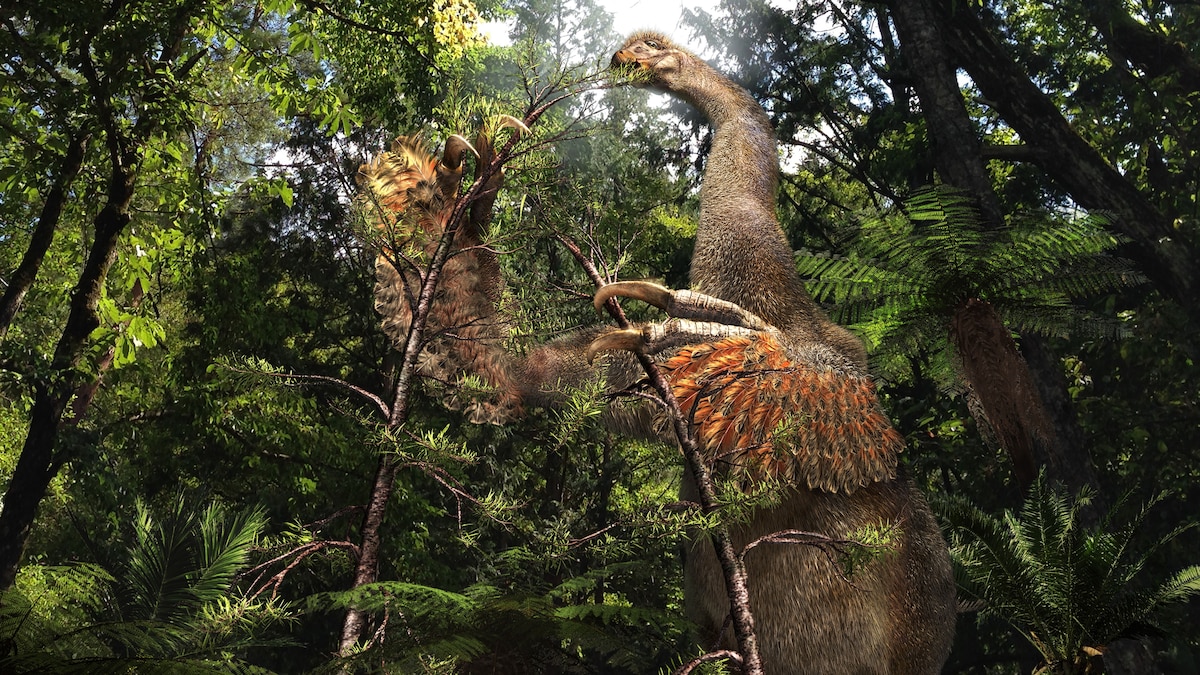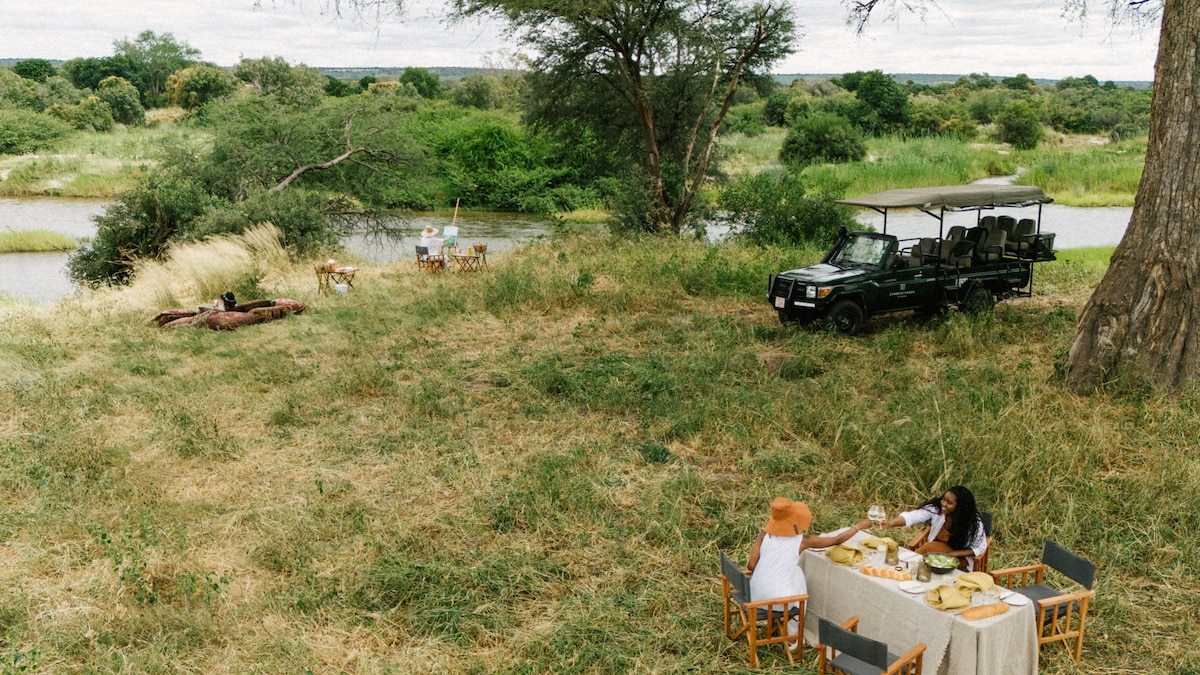Now Reading: This bizarre new dinosaur has something in common with modern sloths
-
01
This bizarre new dinosaur has something in common with modern sloths
This bizarre new dinosaur has something in common with modern sloths

Therizinosaurs were some of the strangest dinosaurs of all time. Descended from carnivores, the prehistoric reptiles were plant-eaters and had fuzzy feathered bodies, small heads with peg-like teeth in their jaws, bulbous stomachs that acted like fermenting vats for heaps of vegetation, and impressively large claws on each of their hands. Their build and claws have drawn comparisons to sloths, but some of these reptiles stood over 13 feet tall and weighed more than five tons. Now paleontologists have uncovered a therizinosaur that stands out even among its unusual relatives—because it’s missing a finger.
Described in the journal iScience today, the new dinosaur comes from rocks in Mongolia’s Gobi Desert that are over 90 million years old. Back in 2012, paleontologists from the Mongolian Academy of Sciences initially unearthed parts of the spine, ribs, hips, and shoulders, and finally found two complete hands. They immediately recognized the fossils as those of a therizinosaur, but its status as a new dinosaur would take time to fully uncover.
When Hokkaido University paleontologist and lead study author Yoshitsugu Kobayashi first saw the fossils the following year, he was immediately surprised that the dinosaur only had two fingers on each hand. Until the new find, all known therizinosaurs had three fingers with large claws at the end of each. “Not only that, but one of the fingers had a preserved keratinous sheath and I was like ‘Holy crap,” Kobayashi recalls.
Kobayashi and his colleagues christened the new therizinosaur, Duonychus tsogtbaatari. The genus name means “double claw”, while the species name honors Mongolian paleontologist Khishigjav Tsogtbaatar.

The Duonychus tsogtbaatari fossils preserve the keratin sheath that covered its bony claw.
Photograph by Kobayashi, et, al
Dinosaur claws were made of bone covered in keratin sheaths, the same biological component as our fingernails. The hands of Duonychus showed that the keratin part of its talons were even longer and more curved when the animal was alive. The claws were capable of grasping branches and other vegetation about four inches in diameter, the researchers estimate, gathering essential food for the 570-pound dinosaur. No one had ever found a preserved keratin sheath from such a large theropod dinosaur before, Kobayashi says.
The fact that the reptiles came in two- and three-clawed forms, similar to sloths, is also surprising. “I would not have guessed that we would see a therizinosaur with just two digits,” says University of Birmingham paleontologist Stephan Lautenschlager, who was not involved in the new research. But given that several other theropod dinosaur lineages have evolved reduced numbers of fingers, the fact that a two-fingered therizinosaur existed makes sense.
(This dinosaur had tinier arms than a T. rex.)
Why do some dinosaurs have fewer fingers?
Theropod dinosaurs include carnivorous classics such as T. rex and herbivores like the therizinosaurs, as well as birds. All walked on two legs and many had some sort of plumage. Finger count among theropod dinosaurs appears to have been variable. The most famous examples, of course, as the large tyrannosaurs like T. rex itself, bearing only two fingers on short, stocky arms.
But there are other examples of digits lost and gained, as well. The carnivorous dinosaur Gualicho only had two fingers on each arm, too, despite not being a close relative of tyrannosaurs at all. The small, strange dinosaur Limusaurus technically had four fingers, but two were tiny nubs that were no longer functional.
You May Also Like
Dinosaurs thought to be insect-eaters took the trend even further. The enigmatic alvarezsaurs had stumpy arms tipped in a single large claw and several tiny fingers. Even bird wings, Lautenschlager points out, offer a demonstration to the broad changes theropod dinosaur digits and arms underwent.
Paleontologists from the Mongolian Academy of Sciences first excavated the fossils, including two intact hands, in 2012. Other therizinosaurs had been found in the area, so the team immediately recognized the dinosaur but didn’t know it was a new species.
Photograph by Yoshi Kobayashi Hokkaido
The fact that many dinosaurs, and other animals such as horses, have reduced their number of fingers or toes over time is immediately apparent from the fossil record. “Understanding the reasons behind digit reduction, however, requires more detailed work,” says University of Birmingham paleontologist Zichuan Qin, who was not involved with the new study. Each case stands on its own, driven by different evolutionary pressures.
Walking on two legs opened up different evolutionary possibilities for theropod dinosaur hands and arms to evolve in different ways, notes Kobayashi. Large tyrannosaurs captured prey and fed with their huge, powerful jaws, and so the reduction in size and finger count makes sense with how they fed. For other theropods, Kobayashi says, “their arms evolved in all sorts of ways for different purposes.” Some, like alvarezsaurs, evolved stubby arms with large, single claws to scratch at the ground, perhaps breaking into nests of ancient termites and social insects.
Why did Duonychus lose a finger?
In the case of Duonychus, the loss of the third finger may have been an evolutionary happenstance that did not have a particular cost to it. The dinosaur’s wrists were flexible rather than stiff, suiting a grasping behavior. “That’s when it hit me,” Kobayashi says, “that the key was the keratinous sheath.”
The preserved sheath on the finger claw of Duoncyhus resembles a non-retractable cat’s claw. Combined with the flexibility at the wrist, it seemed that Duonychus was using its claws to grasp at plants or tree branches and pull the green food closer. Modern two-toed sloths use their dual claws to pull leaves and branches closer in just this fashion today. Once swallowed, leaves and other vegetation would descend into the dinosaur’s gut, cradled on broad hips and within flaring ribs similar to what’s seen in the fossils of giant ground sloth skeletons.
Previous studies on therizinosaurs predicted that the animals used their claws in this way. “These basically function similar to grappling hooks, and the more curved the better,” Lautenschlager says. The preserved keratin shows how curved these claws could be, he notes, which provided a distinct advantage to a dinosaur raking branches toward itself with such claws. Keratin can re-grow if the thin tip breaks, Lautenschlager points out, which would not be possible if the claw were just bone.
The claws would have also been formidable weapons, whether for defense or in conflicts between Duonychus. “Claws like this should be good tools for grasping, and if they were powerful weapons in intraspecific competition, I wouldn’t be surprised, either,” Qin says.
Many parts of the animal body are multi-functional, especially structures such as claws, and so hooked fingers that helped Duonychus feed could have also helped the waddling herbivore fend off predators or discourage other Duonychus that got too close for comfort. Just because Duonychus fed on plants and resembled a giant potbellied sloth doesn’t mean the dinosaur was all soft.
























